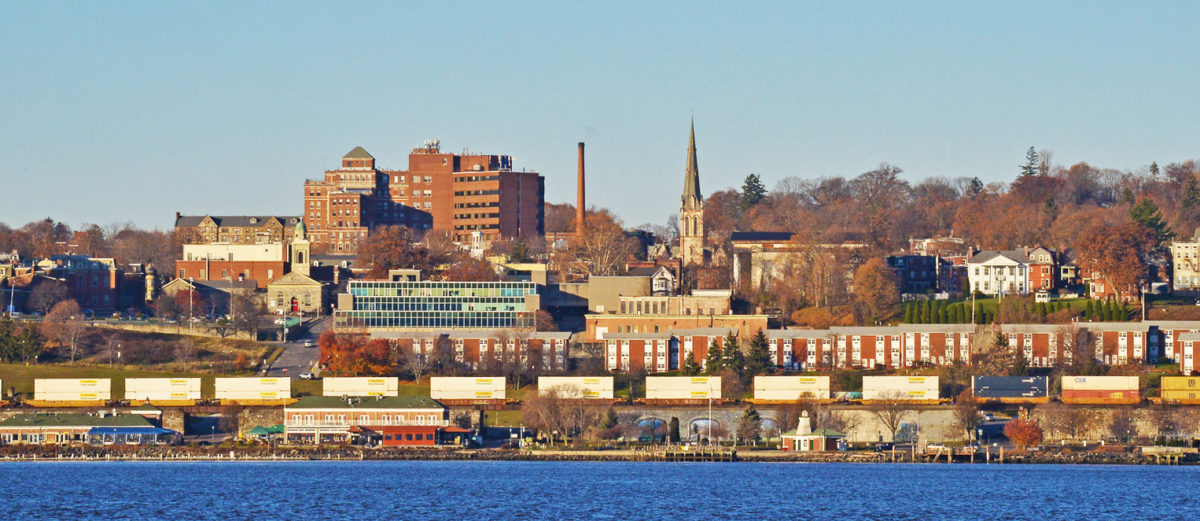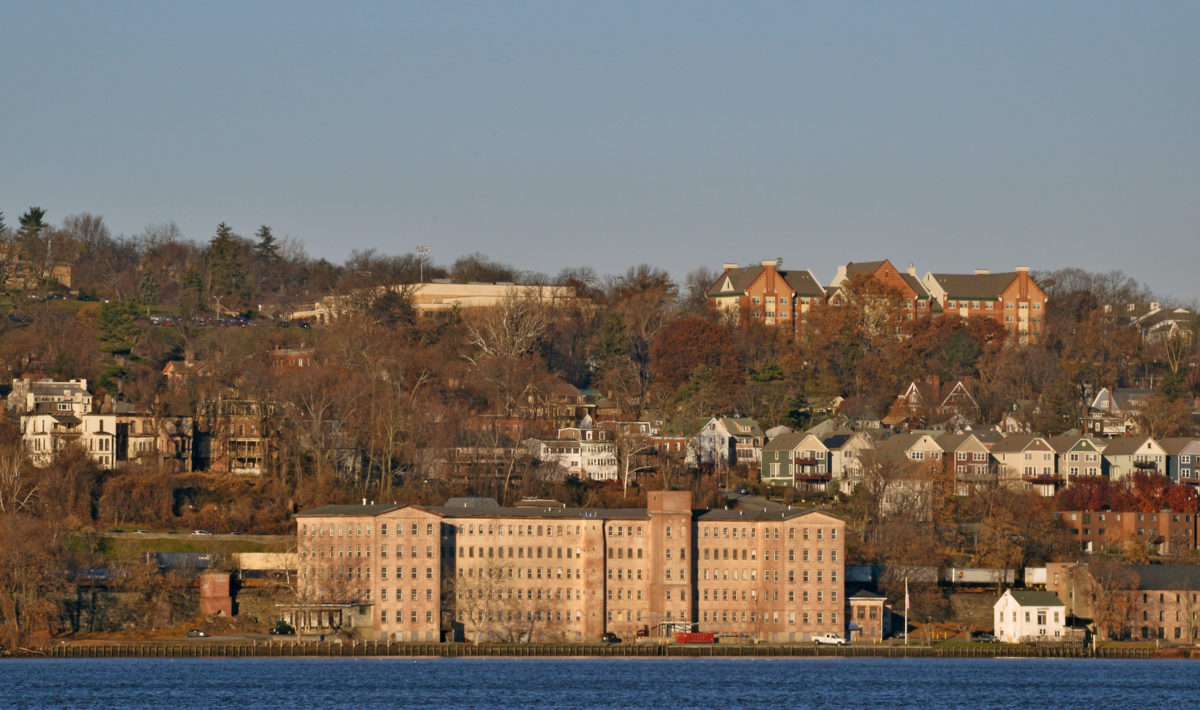
To understand where the metropolitan region could be headed, look to Newburgh in the Hudson Valley.
The Orange County city of just under 30,000 was identified as a “flagship place” in a report recently released by the Regional Plan Association, an urban research and advocacy group. It sets a roadmap for planning and governance over the next 20 years in the three-state New York metropolitan region. The RPA uses a hypothetical 2040 Newburgh as an example of what that plan could look like in action.
While the RPA is not a governing body, its board is made up of influential business leaders, real estate developers and academics. The recommendations in the plan could hold sway with municipalities in the region.
The plan is just the fourth released by the group in its nearly 100-year history. It covers a wide range of issues, including transit, climate change, affordability and how to fix failing institutions.
“The region may look great from Fifth Avenue, but in many neighborhoods across the five boroughs and in places like Paterson (New Jersey), Bridgeport (Connecticut) and Hempstead, it doesn”™t feel that way,” RPA President Tom Wright said in a press release accompanying the report. “Commutes are longer than ever, housing more expensive and climate change is exposing real long-term vulnerabilities.”
The report includes an overall vision and 61 specific recommendations to address some of those concerns. Its major recommendations include modernizing and expanding New York City’s subways; combining the three commuter rail networks into one “Trans-Regional Express”; establishing a Regional Coastal Commission to prepare for rising sea levels and updating local zoning to allow for more multifamily development around public transit stations.

To better illustrate what the plan”™s dense web of recommendations and initiatives would look like in action, the RPA spotlighted nine flagship places, a mix of neighborhoods, cities and counties spread through the region.
The plan describes what Newburgh could look like by 2040, should the municipalities in the region follow through on its recommendations.
This hypothetical scenario describes 2040 Newburgh as an “equitable, healthy and sustainable city” thriving as a “gateway to the Highlands and the Hudson Valley.” The city got there by building on its affordability, historic urban fabric, ferry access to the Metro-North Railroad in Beacon and proximity to freight and highway infrastructure.
In this future, Newburgh has spent the past two decades building a new central business district by “improving the digital infrastructure ”” seeded with state and local government support ”” that allows newer, smaller businesses to flourish,” according to the plan. “Municipal partnerships with Mount St. Mary College and Saint Luke”™s Cornwall Hospital included collaboration on workforce development, a ”˜buy local”™ strategy and reciprocal capital and economic investments.”
Meanwhile, an improved bus rapid transit system has eased congestion on Route 17 and Interstate 84 and connected Newburgh”™s downtown to an expanded Stewart International Airport. A green trail connects Newburgh’s neighborhoods to its waterfront, where the city has added apartments and retail through mixed-use, transit-oriented development around its ferry terminal to Beacon.
For housing, anti-displacement measures and strong rent regulations recommended in the plan helped the city upgrade its housing stock while remaining a diverse home to people from different races, ethnic groups and income levels. The Newburgh Land Bank, formed in 2014, helped in that effort by rehabilitating blighted properties and supporting mixed-use development, according to the plan.
Those residents save on energy costs and are kept cool in the summer by state-of-the-art green infrastructure technologies such as rain gardens, green roofs and cool and permeable pavement, measures that contribute to the restoration of Lake Washington.
That”™s the vision, anyway. How does the RPA recommend Newburgh get there? The report includes a number of recommendations relevant to Newburgh and the rest of the tristate region.
Ӣ Create a tristate trail network. The RPA recommends a network of biking, hiking and walking trails that would better link the regionӪs distinct areas of natural beauty, such as the Catskills to the beaches of Long Island. Doing so could boost recreational opportunities for residents and catalyze economic development.
Ӣ Reduce reliance on local property taxes. Overreliance on local property taxes, according to the RPA, reinforces inequality and incentivizes municipalities to produce less housing and more sprawl. Instead, states should assume a larger share of local school budgets, increase incentives for shared services and encourage municipalities to diversify sources of revenue with income taxes and more innovative property tax structures.
Ӣ Restore regional job centers. The plan notes the economic resurgence in New York City has bypassed smaller cities such as Newburgh, Poughkeepsie and Bridgeport. But the RPA argues that these older jobs centers can again become centers of employment.
While New York City has grown 20 percent in population over the past 50 years, the next 10 largest cities in the region have had a combined population drop of more than 100,000. The RPA says that loss of population could actually be seen as an advantage. Cities such as Newburgh have vacant and underutilized land that could be used for new industries. The older cities also often have the walkable street grids in demand today to help attract residents. Investment in infrastructure, transit and streetscapes can help unlock that potential, the plan argues.
”¢ Expand affordable internet access across the region. The region’s access to high-speed internet lags in comparison to other major metro centers, according to the RPA. High-speed access is available only in some parts of the region and is more expensive than in many similar metro areas. In New York, the RPA recommends the state government provide incentives and technical assistance for small municipalities to pursue expanded broadband systems.
The full, nearly 400-page report is available at www.fourthplan.org





















Trail networks are a horrible waste of money and resources. The Hudson Valley has more than enough trails. An investment of infrastructure is needed to benefit the region. Passenger train service on the west shore csx river line to serve West shore communities like newburgh, Kingston, cornwall, haverstraw and Points South would be greatly beneficial. Giving commuters a faster, more direct access would be key to the region and rail travel is the most eco friendly for commuting. Newburgh also needs to attract corporations and business offices to the city. Creating higher profile jobs into the city itself. Further modernization and development is also needed in the city. Too many older Hudson Valley residents are too short sighted to see the region only benefits from modernization and modest development, the city of newburgh can benefit most from it. Having an affordable light rail network would be a helpful benefit as well, connecting the community to the airport and all over the city and local region. The region has so much potential, great location and room to grow and needs bigger and better goals than a pointless trail network and cheap internet.